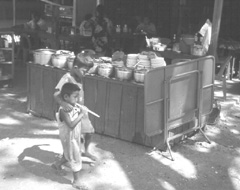
Low budget meals are very easy to come by in Southeast Asia, but they may take a while getting used to since the food is often different than what you might expect. Consequently, on arrival in Bangkok or Singapore you may be attracted to the ubiquitous fast food or Western-style restaurants, but after a couple of meals you should begin to question why you are doing this, since you can get the exact same food back home. Did you come half way around the world just so you could eat meals with other white people around, using an English menu? Probably not.
Sit-down, indoor restaurants with local fare are in all the larger towns and cities, but the food and atmosphere are often too bland for the price. The cheapest and most interesting meals in Southeast Asia can be termed generally as street food, also known as hawker food in Malaysia, Singapore and Brunei. Carts, tables, stands, benches, chairs and stools are set up along the sides and corners of streets, sometimes concentrated in and around the central town market. Where there is no electricity, kerosene candles create a very beautiful scene in the evening. As an added bonus, these are also the places where you will have the best opportunity to practice your language skills, since we all have to eat some time and the people who run these stands almost universally don't speak English. You'd be surprised how much fun you can have after the cook gets over the initial shock of having a white person sit down at her table. These are very good places to make friends with the locals.
If you don't know what to order, try to look around at what other people are having, and just point to a dish. In Cambodia and Burma, they usually have pots of meat, vegetable and noodle dishes sitting out, and you can feel free to lift up the lids to inspect their contents. When you find a dish that looks palatable, just point to it and they'll give you a healthy serving.

Pick and choose from the pots, a typical market eatery in Cambodia.
Away from the most touristy restaurants, there will generally not be a menu with prices listed. Therefore, to reduce confusion, try to find out what the going rate is for a plate of rice with chicken and just specify beforehand that that is how much you want to spend. This way, your dish will be sized accordingly. After you’re in a country for a while you will get a good understanding for how much things should cost, so if you’re being ripped off you can say so with confidence. In my experience this rarely happens. Chicken, beef and pork dishes are usually about the same price, with fish dishes being a bit cheaper. The following table is a rough guide. By the time you read this, the local price will undoubtedly have changed, but the fare in USD should be roughly the same:
-Burma k 100-200 USD 0.3-0.6
-Cambodia r 1500-2500 USD 0.4-0.7
-Laos k 3000-4000 USD 0.5-0.6
-Thailand B 20-25 USD 0.5-0.7
-India (vegetarian) Rs 20-40 USD 0.5-1.0
-Malaysia RM 2-4 USD 0.5-1.1
-Bangladesh Tk 30-50 USD 0.6-1.0
-Nepal (mountains) Rs 40-150 USD 0.6-2.3
-India (meat) Rs 30-50 USD 0.7-1.2
-Nepal (city) Rs 60-80 USD 0.9-1.2
-Singapore, Brunei S$2-3 USD 1.2-1.7
Note that in India vegetarian food is much more common (and much cheaper) than meat dishes, since most Hindus are vegetarian. In the mountains of Nepal, dhal bhat (rice w/ lentils) is the standard fare, usually served all-you-can-eat with a side of vegetables (potatoes and spinach). The price varies dramatically with elevation, number of tourists and distance from the nearest road.
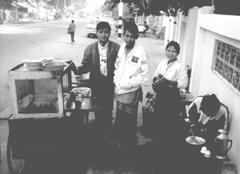
The morning "mohinga" stand in Burma.
For details and advice on the cleanliness of street food, see 12. health on the road.
Along the tourist tracks in every country there are always Western style, sit down restaurants with English menus and a semblance of good hygiene Unless you are way out in the real boondocks, really off the beaten path (difficult to find these days), these places will be hard to miss. SE Asians are not dumb: there is good money to be made by offering foreigners a quality, clean sit down menu meal. Restaurants are nice sometimes because you don't have to guess about the food too much, and you can hang out with other travelers to get the low down on the next place you're heading. The negative is that they can be up to several times the price of a street stall meal, especially in Cambodia and Burma. Food is always cheapest on the street or in the market. Laos and Malaysia are two nice exceptions to this rule, where abundant, reasonably priced restaurants are frequented by locals and foreigners alike. Again, don't expect the prices to always be on the menu. To avoid ugly scenes, it's best to just agree on a price before you order it. Prices are negotiable if they're not written down anywhere, but generally a deal is arrived at quickly. Finally, if you ever come across a restaurant with prices quoted (menu or verbally) in US dollars, bail immediately. I guarantee the place will be a rip off.
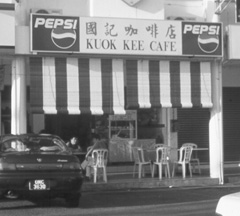
The run-of-the-mill Malaysian-Chinese cafe.
When contemplating restaurants, just remember that these places are overly sterile in the sense that they are not the way to learn about the country you are in. Locals rarely eat in these places, because they are simply too expensive. You can get steak and chips in Siem Reap for a few dollars, but why do that if you can get rice and chicken for 50 cents, and at the same time make a few friends? Eggs and toast may run you 4 dollars at your guest house, but hearty "nombenchok" noodles from the lady down on the corner will be under 30 cents. What I'm trying to say is, why the hell come to Asia to eat like you're at home? Think about your goals again. I never once spent more than two dollars on a single meal in Southeast Asia, and that was a big splurge in Yangon. If you really want, you can eat for under one dollar per day in Burma, Laos and Cambodia. I'm serious.
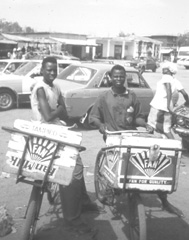
"Fan Ice, so nice!" – an excellent treat in steamy Ghana.
Contrary to what you may think, not all Asians use chopsticks all the time for all their meals. In Bangladesh, some Muslim restaurants in Malaysia and Brunei and in rural areas everywhere, eating with your hands and nothing else is the norm. There is generally a sink in the back with soap and running water for you to wash up, or there will at least be a huge bowl of water on the table for the same purpose. Eat with your right hand only, as the left hand is used for toilet purposes. After eating, pick up the bowl with your left hand and pour water over your right hand, letting it drain onto your now-empty plate.
Elsewhere you will rarely run into a situation where only chopsticks or only spoons are available. Usually the table or stall will have a little cup in the middle holding lots of chopsticks and spoons. When eating rice-based dishes, most people use spoons, whereas when eating noodle-based dishes, most people use chopsticks. If you’re no good with chopsticks and don’t see any spoons, just ask, and usually one will appear. You should at least wipe your utensils off onto your shirt, since you have no idea what’s on them. Forks are generally only available in nicer sit-down restaurants.

If I can do it, so can you (Singapore).
In the US or in Europe, the cheapest way to get a full meal is by self-catering from a supermarket. You pick up some bread, PB&J, bologna, mayo, fruits, whatever. But not so in Southeast Asia. Supermarkets are rare outside of the big cities, and local outdoor markets usually stock stuff which needs to be cooked (rice, meat and vegetables, for example). Even so, do you really want to trouble yourself with porting bags of food when you're trying to travel lightweight? Do you really want to eat by yourself when street food is so cheap anyway? Use the markets to pick up a few fresh fruits or baguettes for the road, but otherwise eat out on the streets with everyone else.
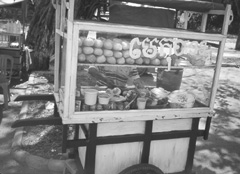
The ubiquitous baguette man (French Indochina – Cambodia).
If you're really set on reducing your costs to an absolute minimum, and want to get the most out of your trip, again I emphasize that you should really be making some friends with the locals (see also 9. where to stay and 10. how to meet locals). Not only do local friends teach you everything you'll ever want to know about the country you're in, but they'll know the absolute cheapest places to eat, and chances are that they'll invite you over to stay and eat in their home sometime. You'll try some very interesting dishes that can't be found at the street stalls. How about boiled grubs and red ants? Snails from the local stream? Water beetles with soy sauce? Whole fish roasted over an open fire that were still writhing a minute ago? A slab of pig fat wrapped in sticky rice? These are just a few of the odd delicacies that I’ve tried. They may sound strange, but I guarantee that you'll be happy and that your hosts will be honored to have you over.
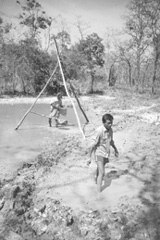
Gone Fishin’, Cambodia-style
I cannot emphasize this point enough. Southeast Asians are generally quite hospitable, especially in the poorer countries of Burma, Cambodia, Laos and Bangladesh, and you shouldn't have a problem with getting invited to stay for as long as you wish sometimes. Take these people up on their offers to learn a little about their daily lives and customs, to rest your travel-weary bones, and to reduce the average costs of your journey. This doesn't mean that your stay will be free, since you should offer to buy groceries or pay for the rickshaw ride on occasion, but it will be significantly cheaper than the normal daily grind.